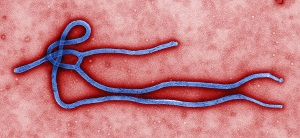 |
| Ebola virus under an electron microscope--Courtesy of CDC |
The Ebola crisis has reignited interest in green, plant-based production of drugs and vaccines, but also highlighted a problem with the approach: There isn't much capacity. Officials in the U.S. are trying to find ways around the capacity bottleneck.
Production of Mapp Biopharmaceutical's antibody combination treatment for Ebola is underway again at a tobacco farm in Kentucky, but officials only expect it to manufacture 10 to 20 courses by the end of the year. To scale up production toward the levels that are needed, U.S. officials are talking to other companies with tobacco plant-based manufacturing capabilities. Bryan, TX-based Caliber Biotherapeutics is one of the firms in the running, The New York Times reports.
Caliber claims to run the world's largest plant-made pharmaceutical facility, but its output could prove insufficient if the Ebola outbreak escalates. Estimates of how much Caliber and other plant-based facilities could produce vary. Dr. Brett Giroir, CEO of the Texas A&M Health Science Center, said Caliber--a company with which his organization collaborates--could produce hundreds of courses a month. A federal official thinks Caliber and other facilities could manage 40 to 100 courses a month.
Either way, capacity is a potential bottleneck and as such, U.S. officials, the Bill & Melinda Gates Foundation and the Wellcome Trust are looking into alternatives. If Mapp Biopharmaceutical's ZMapp can be produced in animal cells, the anti-Ebola effort can tap into existing biologics capacity. While production in Chinese hamster ovary cells should be possible, this method is unlikely to be ready until next year. The need to test if the drug is comparable to the tobacco version could add another delay.
In the longer term, the capacity bottleneck for plant-based drugs can be cleared. "Seven to 10 years from now, plants might be the dominant vaccine-production system," Giroir told Reuters.
- here's the NYT piece (sub. req.)
- check out Reuters' feature